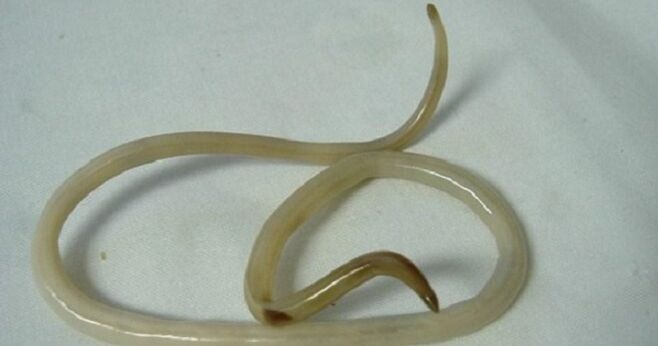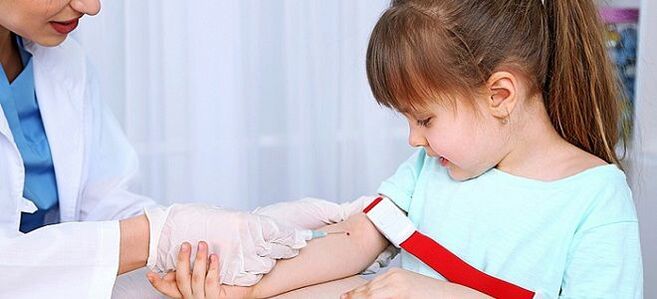
Parasites can infect everyone, but they affect babies in particular, and the risk is especially high in the summer. There are different types of worms, but all have negative effects on health. Parents need to know what worms their children have - below we look at the symptoms and treatment of a disease like helminthiasis.
Types of worms in humans
There are 12, 000 worms on our planet (also called helminths). They live in soil, food and animals, while about 200 species can live in the human body. Parasites must always be their hosts and often choose infants as their habitat. When a child gets to know the world, he tastes everything that is at his fingertips, so he is constantly in danger.
The most common types of worms in children are nematodes or tapeworms. These include:
- Wormwoodcauses ascariasis. The helminth samples are large and can reach a length of 40 cm, parasitizing the gastrointestinal tract and small intestine.
- Pinwormscauses enterobiasis. The worms are small (less than 1 cm) and whitish yellow in color. Such helminths live in the caecum or small intestine in children. Their life cycle is up to 4 weeks.
- Cestodoses- These are tapeworms that parasitize the intestines and various organs. Helminths cause diseases such as teniosis, echinococcosis, hymenolepiasis, teniarin, and difylobothriasis.
- Trematodosesflatworms or trematodes. These include catnip, the paradoxical leukochloridium, the schistosome. Parasites provoke diseases such as fascioliasis and opisthorchiasis.
Ways of infection with worms
According to official medical statistics, worms occur in 80% of cases in children under 2 years of age and in preschools attending educational institutions. These official data were recorded in babies who underwent laboratory testing. Helminths enter the human body in all sorts of ways. The most common types of infection are:
- dirty hands or contact with infected animals;
- poorly washed fruits or vegetables;
- raw water;
- poorly processed fish or meat.
How to understand that a child has worms?
In order to answer the question of what worms are in children (symptoms and treatment are determined by the type of helminths), you need to know how the infection occurred and which internal organ the parasites got into. Very often they do not manifest in any way and the disease progresses in a latent form, so the doctor is not always able to determine their presence. Helminths live in the human body for years, even decades, adapting to the most unfavorable conditions.
Common signs of worms in children may include:
- nausea in the morning;
- anal itching;
- headache;
- bruxism - gnashing of teeth in a dream;
- copious salivation at night;
- dizziness;
- nasal polyps;
- inflammation of the genitals;
- intermittent pain around the navel;
- lamb stools, diarrhea or constipation;
- anorexia;
- pallor of the skin.
If you find more than five of these symptoms in your child, you may want to recommend a helminthic invasion. Each person can carry a variety of helminths that parasitize the body and lead to poisoning and serious illness. By activating the parasites, the signals may change. If you suspect worms in children, symptoms may include external signs:
- "chick" (rash) on the thigh or forearm;
- bruises and circles under the eyes;
- early tooth decay;
- lack of body weight;
- brittleness of nails and hair;
- growth disorder;
- allergic reactions.
Children's worms can affect the nervous system:
- babies will be irritable;
- the concentration of attention decreases;
- endurance is lost;
- sleep disturbance.
What do worms look like in a child's stool?
Young parents are very often interested in the question of how to detect worms in a child’s stool. In fact, only large worms are seen in the feces of children. Parasites leave the body in blood clots that contain only a few individuals. If you see foreign inclusions, it is better to contact a specialist and perform tests to rule out the presence of parasites.
Worm tests in children
When parents suspect worms in their children, the symptoms and treatment depend on the stage of the disease. The child should be taken to a gastroenterologist or pediatrician to make a diagnosis. The doctor will perform an initial examination and prescribe an examination that includes:

- enzyme immunoassay - helps to recognize the type and presence of the worm by taking blood from a vein in a child on an empty stomach;
- blood test for helminths in a child - the main indicators are the number of eosinophils, the presence of anemia and the color indicator;
- scraping, smearing for enterobiasis - from the anus;
- a general analysis of faeces for eggs and dysbacteriosis is carried out in three stages, as certain types of worms do not lay eggs regularly;
- computed tomography, radiography or ultrasound to detect the presence of worms in the human body.
The child has worms - what to do?
After confirming the diagnosis, the doctor prescribes treatment for the worms in children, medications must be strictly agreed with the doctor), talks about folk methods and products to be used for rapid recovery. Parents should be aware that infants should not be given medication on their own, as this can lead to irreversible consequences and thus worsen the condition of the child.
If you do not know how to get rid of worms in children, consult a specialist who will describe several stages of therapy. They include:
- body preparation - in which case sorbents and antihistamines are prescribed;
- anthelmintic therapy - conventional antiparasitic drugs in the form of tablets, suppositories or suspensions;
- body cleansing - enemas, choleretic drugs or sorbents.
In children, worms are treated at home if there are no complications in the form of infectious lesions. The child should follow a special diet at all times. After the first therapy, the child is re-examined and tested. If the presence of parasites in the body is detected again, the drugs will be re-prescribed.
Pills for worms for children
There are currently a number of medications that can help get rid of worms. They are available as tablets and are made for babies. Consult a specialist before use.
Suspension from worms for children
If your child is still small and does not know how to take pills, specially formulated suspensions are suitable for them.
Folk remedies for worms in children
With traditional medicine, it is impossible to get rid of the parasites completely, but it can increase immunity and speed up treatment. Medicines used to treat worms in children should be taken with caution and only with your doctor's permission. The most popular products are:
- garlic;
- pumpkin seeds;
- beet juice;
- vegetable oil;
- celandine and wormwood or tansy infusions.
Prevention of worms in children
All parents should be aware that anthelmintic tablets can be given to children for prevention to create a special microflora in which helminths simply cannot exist.
In order to avoid becoming infected with parasites, you should do the following:
- Follow personal hygiene rules.
- Wash hands with soap and water after using the toilet and walking.
- Fight the flies.
- Keep the pacifier and toys clean.
- Iron clothes and linen.
- Handle food with care.
Depending on the age of the baby, there is a difference in the prevention of worms in children, and medicines are only started from the age of 6 months.
























